Elizabethan Hello! Magazine
> Mrspaine
> Resources for school
> Year 8
Getting Clean, the Tudor Way. In addition to providing clean clothes, linen could also be employed to cleanse the body actively.
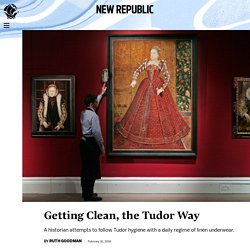
About Tudor Explorers for Kids. The golden age of exploration began in the 15th century and lasted more than 200 years.
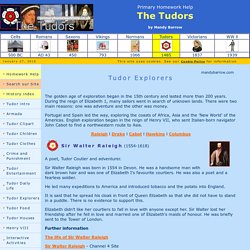
During the reign of Elizabeth 1, many sailors went in search of unknown lands. There were two main reasons: one was adventure and the other was money. Portugal and Spain led the way, exploring the coasts of Africa, Asia and the 'New World' of the Americas. English exploration began in the reign of Henry VII, who sent Italian-born navigator John Cabot to find a northwestern route to Asia.
Raleigh l Drake l Cabot l Hawkins l Columbus A poet, Tudor Coutier and adventurer. Sir Walter Raleigh was born in 1554 in Devon. He led many expeditions to America and introduced tobacco and the potato into England. It is said that he spread his cloak in front of Queen Elizabeth so that she did not have to stand in a puddle. Elizabeth didn't like her courtiers to fall in love with anyone except her. Further information The life of Sir Walter Raleigh Sir Walter Raleigh - Channel 4 Site Sir Walter Raleigh Britannia site.
The Time Traveler's Guide to Elizabethan England. From Transportation in the Elizabethan era to what people ate and wore back then, the Time Traveler's Guide to Elizabethan England by Ian Mortimer brings it all to life.Hard Traveling as an Elizabethan in England By Steffi Porter What do you need to know in order to make it in Elizabethan England?

The Time Traveler's Guide to Elizabethan England by Ian Mortimer will tell you everything you need to and want to know. Chock full of historical information, interesting tidbits and fascinating, little-known facts, this book will make you wish you could actually travel back to the Elizabethan era. Because now you are so well prepared for it!
Elizabethan Food, Drinks, and Cooking Methods by Amani Jones on Prezi. Life in Elizabethan England 19: Food. The situation of our region, lying near unto the north, doth cause the heat of our stomachs to be of somewhat greater force: therefore our bodies do crave a little more ample nourishment than the inhabitants of the hotter regions are accustomed withal, whose digestive force is not altogether so vehement, because their internal heat is not so strong as ours, which is kept in by the coldness of the air that from time to time (especially in winter) doth environ our bodies. — Wm.
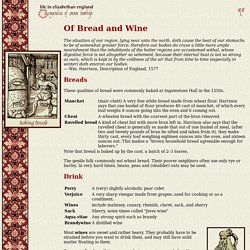
Harrison, Description of England, 1577 Breads These qualities of bread were commonly baked at Ingatestone Hall in the 1550s. Note that bread is baked up by the cast, a batch of 2–3 loaves. The gentle folk commonly eat wheat bread. Drink Most wines are sweet and rather heavy. Sugar and spices ("cinnamon and ginger, nutmeg and clove") are often added to wine and even to beer. Rhenish is a German wine, and very strong. Claret comes from Gascony (southern France). Canary is a white wine from the Canary Islands. 252 gallons. Elizabethan Food. An Elizabethan Family At DinnerBuy at Allposters.com.
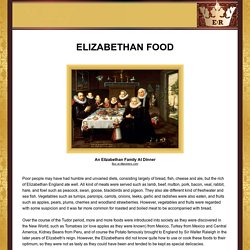
Life in Elizabethan England 45: Filling the Time. As we know, there is nothing as dangerous as a bored nobleman (unless it's an idle soldier).
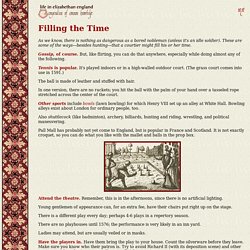
These are some of the ways—besides hunting—that a courtier might fill his or her time. Gossip, of course. But, like flirting, you can do that anywhere, especially while doing almost any of the following. Tennis is popular. It's played indoors or in a high-walled outdoor court.
Pastimes of Elizabeth I. The Elizabethan age is celebrated for its literary and dramatic culture, its music and chivalry.
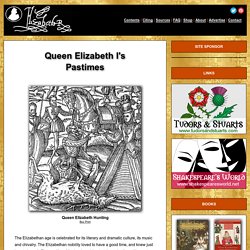
The Elizabethan nobility loved to have a good time, and knew just how to have it. The wealthy of the land would entertain each other with great banquets of rich foods, wine, music and dancing. They would play games against each other, play sports such as tennis or bowls, and they would ride and hunt. Women too would participate in some of these sports, aswell as play musical instruments, draw, sew and embroider. When Queen Elizabeth was not busy with matters of state, she too would enjoy some of these pleasures. Queen Elizabeth's HorseBuy Print Elizabeth loved to horse ride. Elizabeth also loved to hunt.
Entertainment in Elizabethan England - bear baiting, chess, and more. Shakespeare: General Q & A What types of entertainment did they have in Elizabethan England?
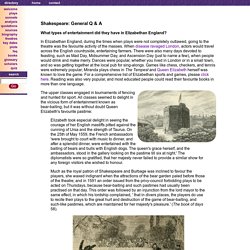
In Elizabethan England, during the times when plays were not completely outlawed, going to the theatre was the favourite activity of the masses. When disease ravaged London, actors would travel across the English countryside, entertaining farmers. There were also many days devoted to feasting, such as Mad Day, Midsummer Day, and Ascension Day (just to name a few), when people would drink and make merry. Dances were popular, whether you lived in London or in a small town, and so was getting together at the local pub for sing-alongs.
Beauty History: The Elizabethan Era. Putting on an Elizabethan Outfit. By Drea Leed This is a listing of the main elements of Elizabethan dress.
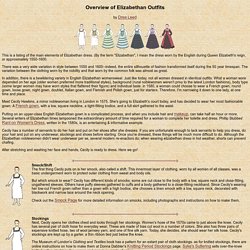
(By the term "Elizabethan", I mean the dress worn by the English during Queen Elizabeth's reign, or approximately 1550-1600. There was a very wide variation in style between 1550 and 1600--indeed, the entire sillhouette of fashion transformed itself during the 50 year timespan. The variation between the clothing worn by the nobility and that worn by the common folk was almost as great. In addition, there is a bewildering variety in English Elizabethan womenswear. Meet Cecily Hawkins, a minor noblewoman living in London in 1575. Putting on an upper-class English Elizabethan gown is a complicated process, and when you include hair and makeup, can take half an hour or more. Cecily has a number of servants to do her hair and put on her shoes after she dresses.
Sports and Games in Elizabethan England. Sports and Pastimes in Popular Use in Shakespeare's Day Part 1: [A-L] From Folk-lore of Shakespeare by T.
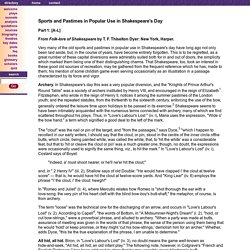
Elizabethan Sports. Most Popular Elizabethan Baby Names. What was the most popular Elizabethan name? A simple question, but one that's almost impossible to answer. Records from that period are scarce, difficult to decipher and were little regulated. Despite all that, below is my study of twenty-three parishes in Norfolk during the reign of Elizabeth I (1558 -1603). Sample: The following rankings have been compiled from a total of 6239 baptism records (3259 male; 2980 female) in the years 1558 to 1603 from twenty-three Norfolk parishes.










